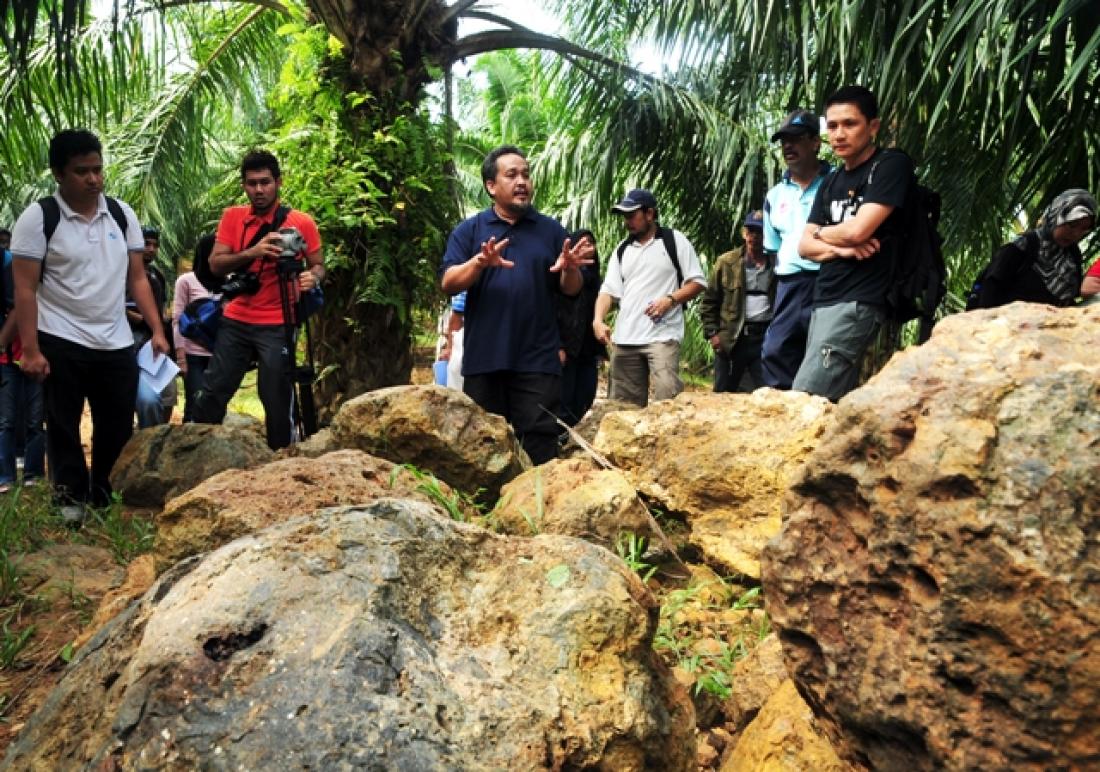PALAEOLITHIC SITE.. Mokhtar (centre) explaining to media representatives about the suevit stone formations containing hundreds of paleolithic stone tools at Bukit Bunuh.
This has made Bukit Bunuh the oldest site in the world outside Africa and which has been chronometrically dated. With this discovery in Bukit Bunuh, the evidence of prehistoric presence in Lembah Lenggong (Lenggong Valley)has been strengthened, and has turned it into one of the most important archaeological sites in the world.
"Evidence found during the research which has been on-going since 2001 in Bukit Bunuh indicates that this site had always been occupied," said Assoc. Prof. Mokhtar Saidin, the Director of the Centre for Global Archaeological Research, Universiti Sains Malaysia.
"Bukit Bunuh was chosen as the site for early settlement as it not only provided the natural resources needed to make stone tools but was an ancient environment that had water resources from ancient lakes, flora and fauna," he said.
The discovery of the use of hand-axes, announced on 2009, indicated that this is the only Palaeolithic site in the world that functioned as a workshop for making stone tools and continued to be used periodically since more than 1.83 million years ago. Currently, the hand-axe is regarded as the oldest tool in the world.
Research at Bukit Bunuh has uncovered evidence of the destruction of the paleolithic culture caused by a meteorite crash 1.83 million years ago. This was provided by geomorphologic evidence, the presence of suevit stone and the geology of the area.
"USM has been appointed by the National Heritage Department to write a dossier (proposal) to UNESCO and this was done, in line with the archaeological research conducted by USM researchers since 1987 and which had a huge big impact on the world," said Assoc. Prof. Mokhtar Saidin to reporters, who were taken on a tour of Bukit Bunuh today.The first draft of the proposal was submitted last year and the final proposal was forwarded by the National Heritage Department to UNESCO in January.
The National Heritage Department has announced that a team from UNESCO is expected to visit the site in July this year and the results will be announced next year.
"This recognition is crucial to ensure that the artefacts, including thousands of suevit stones in this area are preserved as national heritage. There should be on-going research to get a true picture of the people who settled in this area since 1.83 million years ago and this can change several theories about the Palaeolithic people such as the nomadic theory and movement of prehistoric man," said Mokhtar.
Prior to this, the Nomadic theory on Palaeolithic culture stated that they moved from place to place but evidence in Bukit Bunuh shows otherwise, because humans needs go beyond basic needs.
Reporters were taken on a visit and they saw at close range the evidence, including the probability of human bones and the effects of the meteorite crash on the numerous stone fragments and hand-axes found in the area.
"It will be a great loss to the country if the area and the discoveries are not well preserved; what more in our efforts to identify the original inhabitants through the various artefacts that have been found. In most countries, archaeological discoveries and the sites are preserved," said Mokhtar at the end of the visit to the archaeological site, located in an oil palm estate



